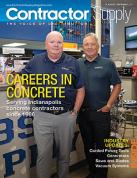Oregon standardizes collaborative-construction process
After finding a way to push forward 365 bridge projects in 12 years, the Oregon Department of Transportation will use the same process to accelerate projects in the future.
The Jobs and Transportation Act, passed by the 2009 state Legislature, requires ODOT to use the collaborative process the department pioneered a decade ago. The process began after Northwest salmon runs were listed under the federal Endangered Species Act.
“That had a pretty profound impact on our ability to deliver projects,” said Hal Gard, ODOT’s Geo-Environmental Section manager. “With the salmon listing, just about any project that touched water had an ESA nexus.”
The salmon listing added another layer to an already complicated process of gaining approval for big projects from various federal and state regulatory agencies. Seeking that approval one agency at a time wasn’t working, Gard said.
“We thought, ‘Why don’t we get everybody in a room at the same time and have one single conversation about a project?’ ” he said, “so we’re not taking an individual document and schlepping it around to all the agencies.”
The Collaborative Environmental and Transportation Agreement for Streamlining, or CETAS, grew out of that. The group has representation from 11 state and federal agencies.
This process was set apart from other efforts by ODOT committing the money for liaisons from each of the other agencies. “We’re basically paying for their time,” Gard said. “By funding the positions, you guarantee that you have people in the room.
Getting people in a room doesn’t guarantee success, especially when they have different viewpoints. Participants didn’t start out trusting each other, said Yvonne Vallette, aquatic ecologist with the Environmental Protection Agency.
Kevin Parrish, project manager for Hamilton Construction, discusses the Willamette River Bridge, an Oregon Transportation Investment Act-funded project. The OTIA III program used a collaborative process to speed the 365 bridge projects. (Photo by Dan Carter/DJC)
Before the group even started considering projects, it took a year for members to become comfortable with each other and to set rules.
“We had to learn to leave our luggage at the door - broken promises, false expectations, all that,” Vallette said.
Regulatory agency officials say that having ODOT discuss projects early in the planning process allows for concerns to be ironed out before they become crises. The process is smoother, said Jon Germond, Wildlife Habitat Resources Program manager with the Oregon Department of Fish and Wildlife. And the product is better for wildlife.
“Everybody gets something out of the process,” Germond said. “By (ODOT) being up-front, we get to give input to make their projects fish- and wildlife-friendly.”
The collaborative framework proved essential when, in 2003, the Oregon Legislature passed the Oregon Transportation Investment Act III. The act, intended to address the state’s deteriorating bridges, added 365 bridge projects onto ODOT’s existing ones.
“That would take 50 years to get that through the process,” Gard said. “The Legislature gave us 12.”
Because of the collaboration it had started with CETAS, ODOT was able to establish broad performance standards, instead of taking every single project to one agency at a time for approval. “We already had a system in place that allowed us to talk to each other,” Gard said.
The Legislature recognized that program’s success and has now written it into law. A section of the Jobs and Transportation Act requires ODOT to work with state and federal environmental regulatory agencies on all state highway construction projects, pointing out the benefits in terms of reduced time and money spent and a commitment to environmental stewardship.
Everyone pays lip service to teamwork and working together across agencies, Germond said. But other states have tried approaches similar to Oregon’s and not experienced the same success.
“Here in Oregon, we do things differently,” he said. “We try to be collaborative and do things together for a common goal.
“We have different values, and it starts with a collaborative attitude.”
Source: DJC Oregon















